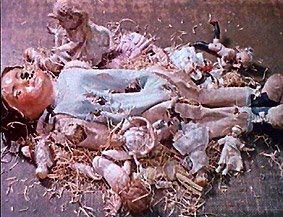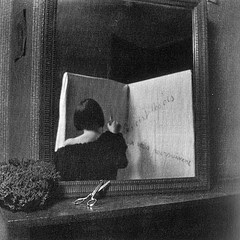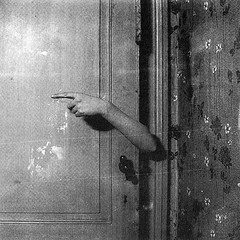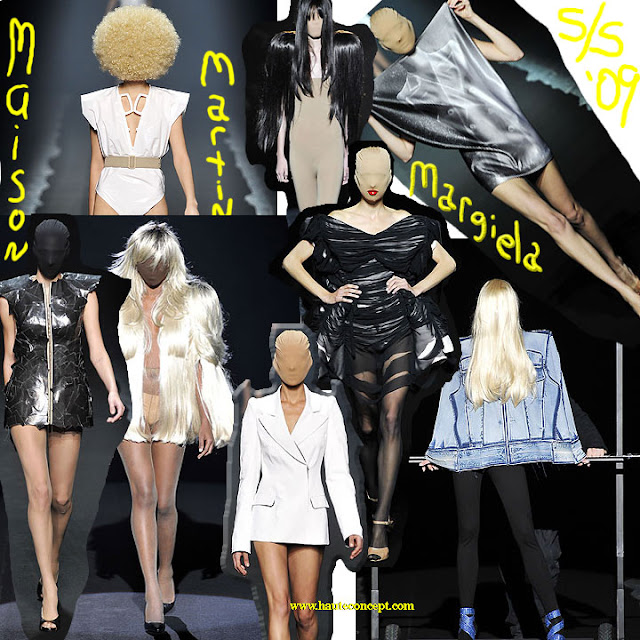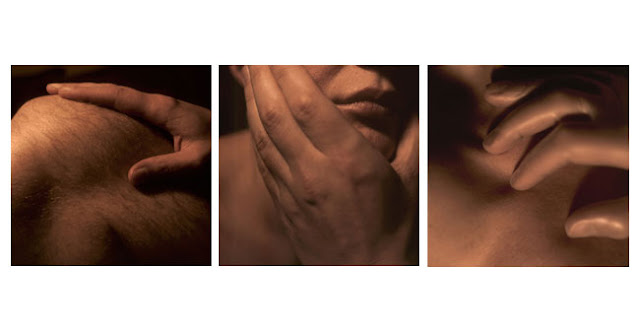Skin; Wellcome collection visited 25/08/2010
http://www.wellcomecollection.org/whats-on/exhibitions/skin.aspx
This is a fantastic exhibition! An exploration of skin culturally, scientifically and through contemporary art and craft, it follows the developments in our understanding, attitudes, decoration and use of human skin from ecorche drawings and etchings from the 15th century through to cutting edge technology used by Marta Lwin to create jewellery from artificial skin.
Looking for practitioners dealing with aspects of haptics and of touch generally. The works referenced here have most relevance to my written paper.
‘Libidinus’ 2010
(Drawing animation 4mins) Rosa and Mercedes Peris.
The artists live and work in Valencia where Juan Valverde de Hamusco taught medicine and anatomy in the 16th Century.
This sensual representation of flaying as a ‘lovers experience’ is paradoxical in that it depicts a process that would be excruciatingly painful and ultimately fatal, in a manner that evokes the physical pleasures of touching and being touched.
A visual metaphor for revelation through intimacy; ‘I’ve got you under my skin’, the notion of getting under the skin of another has connotations of emotional closeness, of being affected by the touch/ presence/ existence of another and also hints at possibilities of obsession. The contradictions of physical love, tensions between the constructive and destructive possibilities of violent and fetishistic acts are suggested here.
The style of the animation; loosely drawn pencil line with smudges of coloured chalk pastel give fluidity of movement creating a confusion of limbs, buttocks, faces, lips, and hair. Movement within the frame, the representation of whole bodies, close-ups and extreme magnification of exposed muscle, evoke the joy of physical contact and of tumbling abandonment to ‘Libidinous’ pursuits and haptic experience.
The childlike lovers, adult lovers and cherubs depicted in succession allude to Baroque representations of the body in paintings and through ecorche figures. Allegorical and mythological tales of Venus and cupid are brought to mind. Both the fleshy voluptuousness of these intimacies and the ephemerality of sensual experience are conveyed through soft smudges of pink and red chalks.
Ultimately it is this lack of definition that detracts from the work as a whole. The viscera and machinery of the body concealed beneath the skin are precise and delineated in their structure and purpose. The muscles, tissues and cells depicted in close-up here are an amorphous and incoherent jumble represented through expressive marks, swirls and splashes of colour that barely begins to suggest the complexity and detail to be found below the surface of the human body. A clearer more clinical rendering of the muscle, tendons and blood vessels would have created greater visual tension in this piece and suggested the levels of anatomical knowledge that had been achieved in the time to which it alludes.
There is a boundary between what is felt and experienced emotionally and psychologically (passion/pain/pleasure) and the physiological; mechanical, chemical, and thermal detections that facilitate perception of sensory experience.
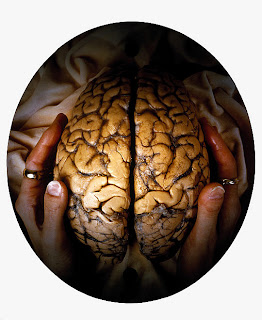 |
Self portrait; 1991 Helen Chadwick
Photographic transparency, glass, aluminium frame and electric lights |
‘Self Portrait’ 1991 Helen Chadwick
Photographic transparency, Glass, Aluminum frame and electric lights.
‘This unsettling yet intimate self-portrait challenges the traditions of classical portraiture by suggesting that regardless of gender, age or race our brains all look the same. However, although this is clearly not the artists’ own brain, her individuality is betrayed by her hands’ exhibition information.
This work comments on the development of scientific knowledge and changes in culture and attitudes towards the human body and the mind by amalgamating both historical and contemporary modes of thinking and presentation.
This image is a contemplation of mortality; the traditional skull has been replaced with the brain to reflect contemporary understanding of its location of consciousness and of the ‘self’. The gathers and folds in the fabric can be seen as a reference to portraits of 17th century in which cloth was often used as a metaphor for civilisation. It also echoes the folds and contours seen on the surface of the brain and it’s lustre and richness suggests the kind of surface that might be used to display an object of great value.
The brain superseded the heart in terms of its perceived importance as the location of the soul and of consciousness. When did this happen?
The exhibition contains a number of wax anatomical models, many of which are displayed on fabric cushions, which was the fashion at that time. Are these the upholstered surfaces of the coffin, or of the sitting room?
The methods used to realise and present this piece are in total contrast to the traditional portraiture and cultural associations to which it alludes. The guts and mechanics of it’s making and display are exposed; lights, wires, screws and wooden base can all be clearly seen through the transparent Perspex that have been used to fabricate the sides of this circular box. This echoes the brutality implicit in the action we see represented before us. The image depicts the artist handing a human brain, the touch appears to be one of tenderness, possibly reverence. However, the image prompts the question; in what circumstances did the brain become available and how was it removed from the body?!
We are divorced from the act of touching through the medium of its representation. A hard glossy, two-dimensional surface, there are none of the tactile or olfactory stimuli that would have been present in the moment the image was created. How many people in contemporary society have the opportunity to handle a human brain in this way? We may be able to imagine how this might feel or smell through drawing on our own memories. Handing of animal flesh and viscera during the preparation of food or the experience of encountering road kill would give some clue. It reminds us of our own mortality and provokes both curiosity and revulsion but also has a strange sterility to it which is alienating.
 |
| Psoriasis; Tamsin Van Essen |
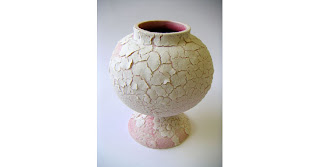 |
| 'Psoriasis' .Ceramic apothecary jar by Tamsin Van Essen 2009. |
Medical Heirlooms; 2008-2010. Tamsin Van Essen. Ceramic vessels.
‘These medical heirlooms address both the stigma of skin diseases and contemporary obsessions with perfection and beauty. The artist Tamsin Van Essen has manipulated ceramic materials to emulate physiological ‘faults, defects and blemishes’. Based on 17th century apothecary jars the forms have strong historical link. The title of the series links an object that can be passed down through generations to hereditary medical conditions.’ Exhibition information
These vessels are connotative of the body as vessel and of the eye. Internal and external spaces/ surfaces are used to explore the concept; one is fractured and flaking, mimicking the blemishes, puckers and distortions of Syphilitic skin.
This is an explicit representation of skin conditions: ‘Psoriasis1’; ‘Psoriasis 2’; ‘Acne (pocked)’; Acne (pustules); ‘Syphilis1’; and ‘Syphilis 2’. The perfect, precise form of the vessels are in stark contrast to the degeneration and pollution suggested by their surface qualities. The progressive disintegration of the surface of ‘Psoriasis’ mimics the shedding of diseased skin over time.
Examination; 1999. Heather Barnett. 3 colour photographs.
‘This photograph series was produced in collaboration with Gynaecologist Kathy Boursicot. Barnetts work is inspire by textbook illustrations of medical examinations, which she re-stages and photographs in a manner that blurs the distinction between clinical precision and sensuality’. Exhibition information
These photographs capture individual acts of touch in the context of clinical examination but the lighting, colour and framing of the acts in close-up creates ambiguity, highlighting the sensual aspects of the process of examination and inviting us to consider the ethics of the doctor/patient relationship.
Enlargement of these interactions between the patient and the doctor emphasises the surface texture of skin, hair and of different parts of the body making them more difficult to identify. The scale and composition of these images abstract the two bodies, intensifying the moment of contact and creating intimacy whilst also transforming the them into a series of landscapes. Tonal contrasts define the form and surface of body parts suggesting the dramatic chiaroscuro seen in Spanish paintings. In one image the ‘examiners’ hand is encased in a latex glove. The tactile properties of this material, its associations with protection, birth control and with fetishistic practices have the potential to affect not only the actual experience of touch and of being touched, but influence the imagined experience of touch in the mind of the viewer.
These images also evoke notions of touch as a transformative gesture, suggesting the spiritual possibilities in ‘The laying on of hands’ and ‘the miracle of healing’.






